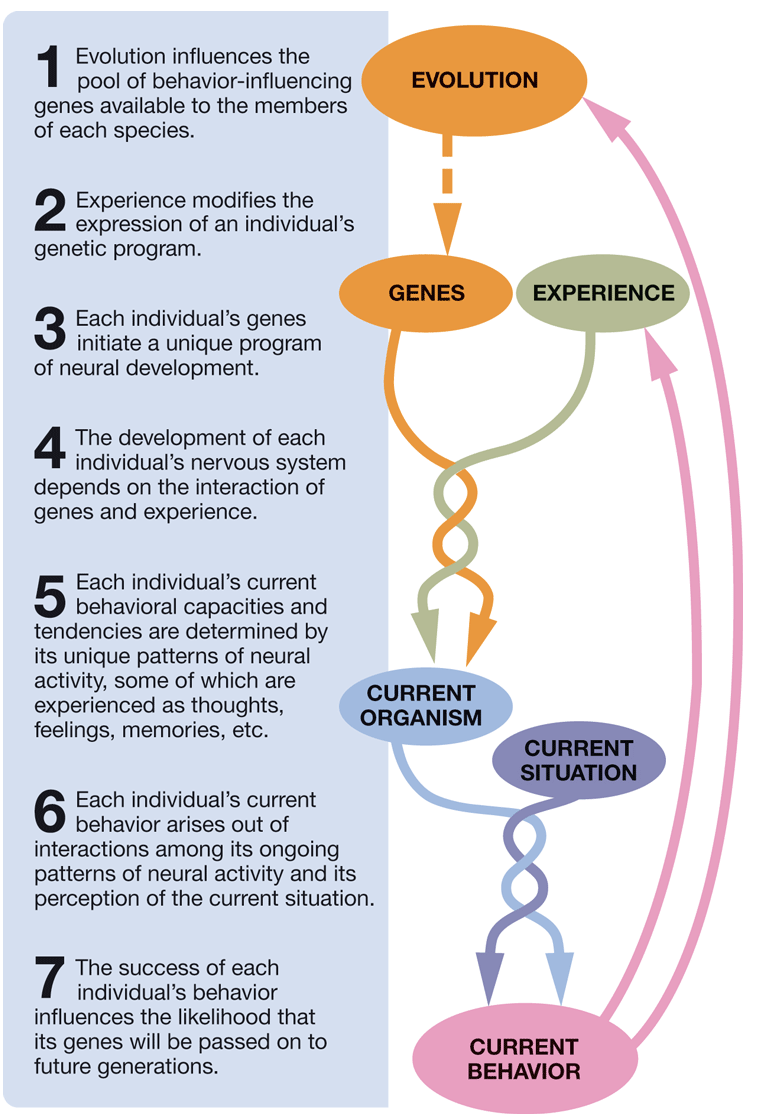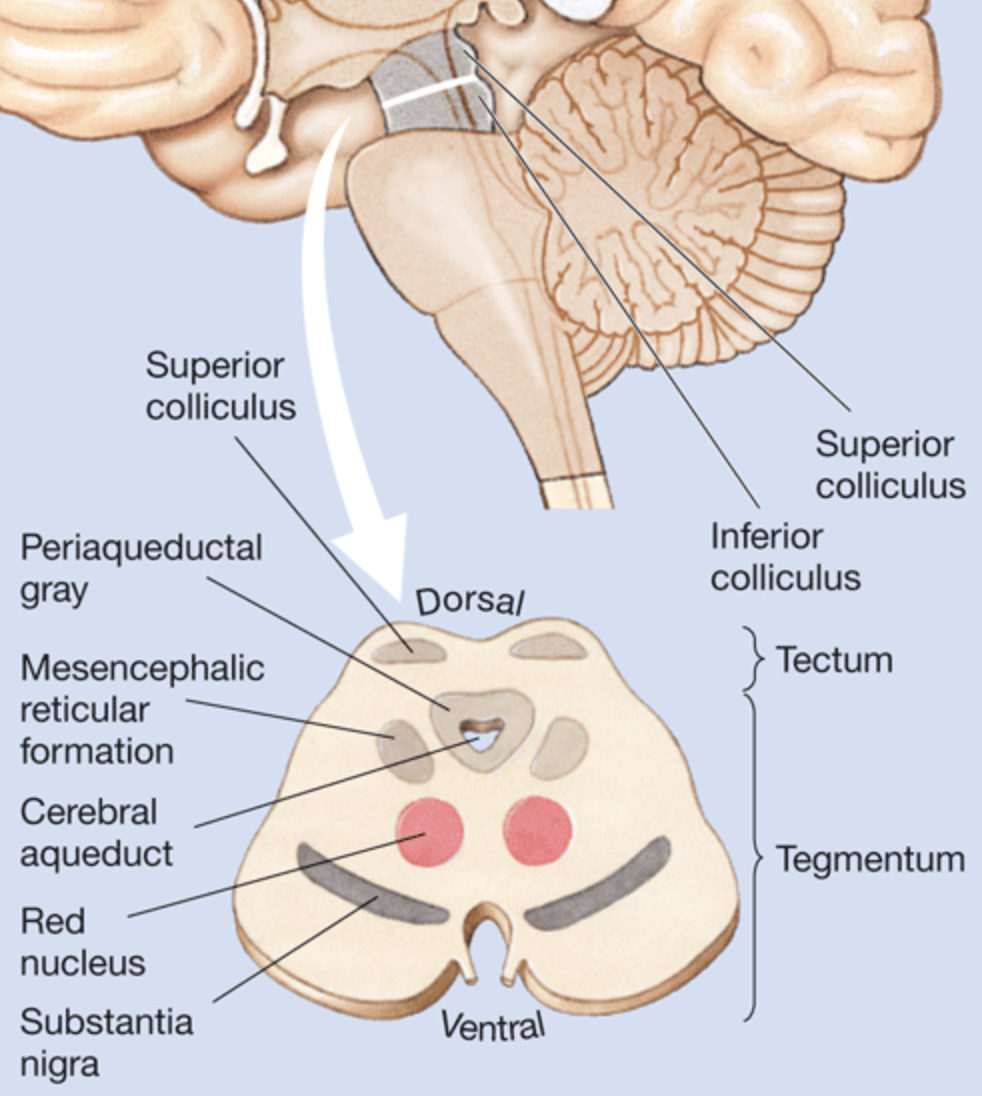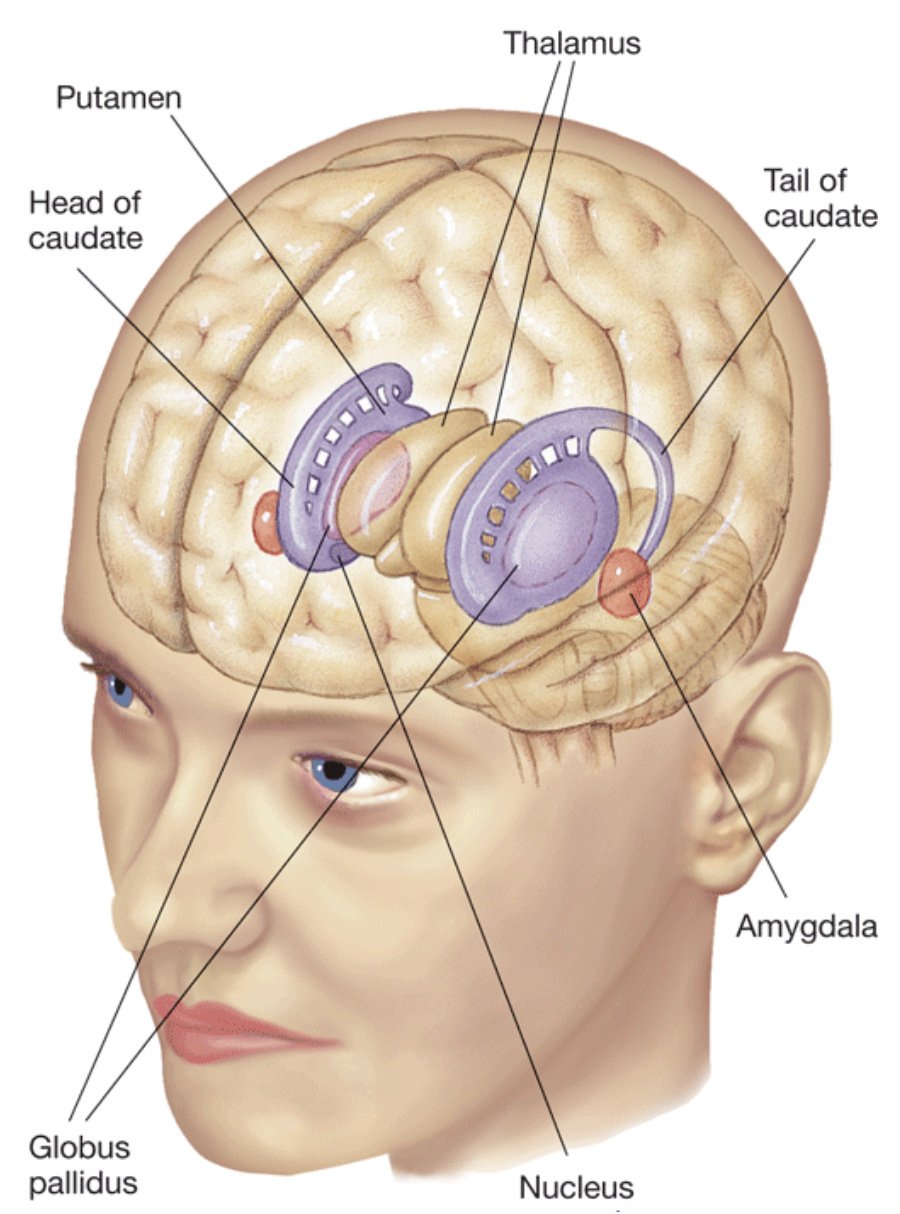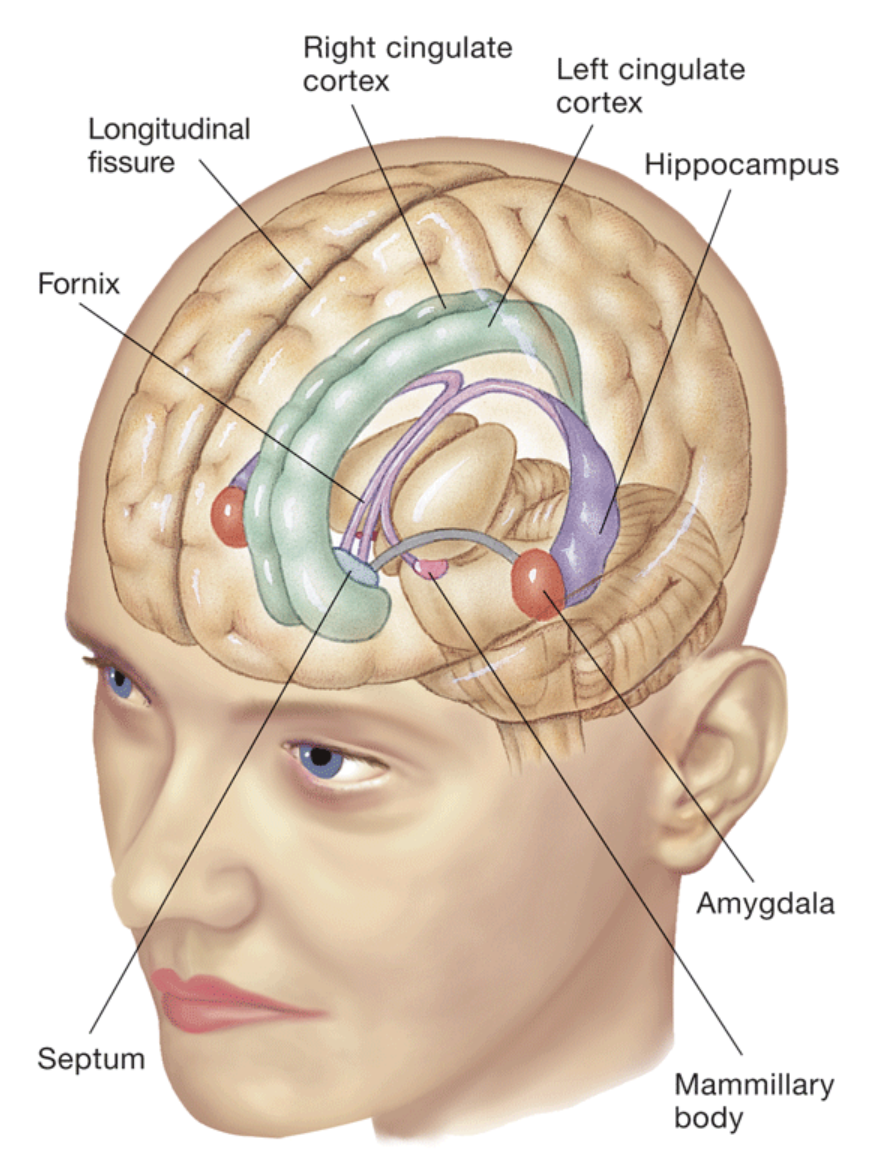PSYC 385 Quiz 1
1/138
There's no tags or description
Looks like no tags are added yet.
Name | Mastery | Learn | Test | Matching | Spaced |
|---|
No study sessions yet.
139 Terms
Biopsychology
The study of how behavior is affected by our biology.
True or False - Biopsychology is a biological view on psychology rather than a psychological view on biology.
True
Thinking Creatively
The first of the four major themes of the textbook that involves thinking in ways outside the norm, yet still productive. Thinking is based on evidence rather than others’ views.
Clinical Implications
The second of the four major themes of the textbook that involves the aspects of illnesses and treatments in biopsychology. Aspect 1 is knowledge coming from analyzing brains that are damaged/diseased. Aspect 2 is applying that knowledge to treat brain disorders.
The Evolutionary Perspective
The third of the major themes of the textbook that involves comparing species’ biological differences to understand the progression over time.
True or False - Changes over time can be determined with 100% certainty.
False
Neuroplasticity
The fourth of the major themes of the textbook that involves the brain’s ability to adapt in response to genetics and experiences, as well as injury. One of neuroscience’s most important discoveries.
Coolidge Effect
Lester & Gorzalka
Men are more likely to have a shorter recovery time if the female being presented is one that hasn’t been interacted with before.
Between design & Pure
True or False - The Coolidge Effect is greater in women than in men.
False
Confound Variable
A variable outside of the independent variable that plays an effect on the dependent variable, making it hard to see if the change in that variable was caused by the intended reason or by something else.
Comparative Psychology
The sixth major division of biopsychology. Using and comparing different species’ biological behavior to draw conclusions on genetics, evolution, and adaptiveness of behavior.
Combines evolutionary psychology and behavioral genetics
Pure Research
When research is conducted only to gain more knowledge on a subject, and is more researcher driven.
Translational Research
Aims to apply pure research into human application.
True or False - Pure research is more prone to political influence, as politicians pay for studies that benefit them.
True
Applied Research
When research is conducted to gain a positive outcome for humanity rather than just gaining knowledge, and is more benefit based.
Experiment
The involvement of direct manipulation to determine if conditions directly cause studied changes.
Quasi-Experiment
Using participants with already-existing real world conditions rather than directly assigning the conditions.
True or False - Quasi-Experiments can test out confound variables, as it has random assignment.
False
Case Studies
When the focus is on a single case, leading to more detail but less generalizability to the greater population.
True or False - Biopsychological conclusion based mainly on case studies should be taken with skepticism due to individual differences.
True
Between-Subjects Design
Each condition is tested by different participants.
Within-Subjects Design
Conditions are tested by the same batch of participants.
Physiological Psychology
The first major division of biopsychology. The study of directly manipulating the brain in experiments to analyze how our behavior changes neurologically.
Surgical and electrical are the two most common methods.
Pure research heavy.
Animals are the focus, and lessons learned are applied to humans.
Psychopharmacology
The second major division of biopsychology. The study of how drugs affect our brain rather than the direct manipulation present in physiological psychology.
Main purpose is to test new drugs to combat illnesses and t lower the abuse of drugs.
Balance of animal and human use due to ethics.
Neuropsychology
The third major division of biopsychology. The study of how brain damage affects our behavior and neurological workings.
The most applied branch due to the main goal, as researchers only aim t benefit people that have been injured.
True or False - Neuropsychology is ONLY case studies and quasi-experiments due to ethics.
True
Psychophysiology
The fourth major division of biopsychology. The study between the psychological and physiological workings within the nervous system.
Focuses on the physiology of psychology rather than the opposite.
Analyzes how our body reacts in different states of attention, emotion, and mental disorders.
Electroencephalogram (EEG)
Electrical nodes connected to the head that analyze brain activity. It’s the most often process in psychophysiology due to non-invasiveness.
Autonomic Nervous System (ANS)
A division of the nervous system that works to keep the inside of the body in equilibrium. This involves heart rate, blood pressure, digestion, hunger, etc.
Cognitive Neuroscience
The fifth major division of biopsychology. The study of how cognition works neurologically.
Youngest division
Relies on humans due to a lack of invasiveness
Uses fMRIs to see where our brain handles types of thought and information
True or False - Cognitive Neuroscience is the most versatile branch of biopsychology, as it is relevant to many fields.
True
Ethological Research
Studying animals within their natural habitat and behavior. Part of comparative psychology.
7 Steps to the Biopsychology Perspective

Neuron
Electric charges that cause the release of neurotransmitters, which produce chemical reactions in the receiving cell.
Neurogenesis
The creation of new cells.
True or False - We have the most neurons right after childbirth.
True
Synaptogenesis
Building new connections between neurons - cell is already there.
Pruning
Taking away connections or even cells that aren’t needed anymore.
Computed Tomography (CT) Scans
A type of structural neuroimaging that involves an x-ray and computer to create images inside the body.
Magnetic Resonance Imaging (MRI)
A type of structural neuroimaging that involves a magnet aligning hydrogen atoms and tracks the alignment signal as they fall back into a resting state.
Program MRIs are used to detect certain things based on what the doctor thinks the issue is.
Functional MRI (fMRI)
A type of functional neuroimaging that shows structure AND activity. It uses the BOLD acronym to show where the brain is recruiting more brain flow.
Relies on the assumption that when we do an action, resources in the area of the brain being used becomes depleted, requiring glucose to be brought in increase blood flow.
BOLD signal
Blood Oxygenated Level Dependent
Used in fMRIs
Positron Emission Tomography (PET)
A type of functional neuroimaging in which a radio labeled glucose (2-DG) is injected to the bloodstream and enters active neurons during specific tasks. The image is made from subtracting the baseline from the activity imaging,
4 Sections of the Biopsychology Perspective
1) Genetic Variance - Need to be a variety of genes to use. (Evolution)
2) Neural Development - Early experience influences neural development (Genes & Experience)
3) Application to New Situations - Individual applies past development to new situations (Current Organism [Genes and Experience mixture] & Current Situation)
4) Outcome Behavior - Behavior contributes to genetic variance (Current Behavior & Start Over)
Dorsal
Towards the head/body’s top. Known as superior in the human head.
Ventral
Towards the chest/head’s bottom. Known as inferior in the human head.
Anterior
Towards nose
Posterior
Towards butt
Medial
Towards center
Lateral
Towards the outside
Proximal
Close
Distal
Far
True or False - Humans’ direction orientation changes based on location from the head to the body due to being upright.
True
Sagittal Plane
The plane that separates the brain into vertical slices, with the edges of the plane being the sides of the head. Looking at a side view into the brain.
Horizontal Plane
The plane that separates the brain into horizontal slices, with the top and bottom of the plane being the top and bottom of the brain. Looking at a top-down view into the brain.
Frontal Plane
The plane that separates the brain into vertical slices, with the edges of the plane being the front and back of the head. Looking at a front view into the brain.
Myelencephalon (Medulla)
The most posterior division of the brain composed largely of tracts of carrying signals between the rest of the brain and the body
Metencephalon
The division of the brain directly above and behind the medulla that houses ascending and descending tracts, as well as part of the reticular formation. Also has the Pons and the Cerebellum.
Mesencephalon
The division of the brain considered the midbrain that contains the tectum and tegmentum.

Diencephalon
The division of the brain above the mesencephalon that is composed of the thalamus, hypothalamus, pituitary gland, and optic chasm.
Telencephalon
The division of the brain that mediates most complex functions, including voluntary movement, sensory input, learning, speaking, and problem solving. The cerebrum.
Brain Stem
The stem on which the cerebral hemispheres sit.
Reticular Formation
~100 Nuclei that involves a large number of functions, including arousal, sleep, attention, movement, muscle maintenance, and other reflexes. It takes information from the brain stem + spinal cord and sends it to the midbrain, keeping regulation within the body.
The Pons covers it.
Past of the Myelencephalon, Mesencephalon, and Tegmentum half of the Mesencephalon.
Pons
The metencephalic structure that creates a bulge on the ventral surface of the brain stem, covering the reticular formation.
Cerebellum
The large structure on the brain stem’s dorsal surface that deals with involuntary movements and reflexes.
Tectum
The dorsal surface of the mesencephalon.
Has the inferior colliculi - auditory function
Has the superior colliculi - visual-motor function
Tegmentum
The ventral surface of the mesencephalon
Has part of the reticular formation
Has periaqueductal gray - gray matter that’s by the back two bumps, sympathetic response and modulation of pain
Has the cerebral aqueduct - duct connectiong the third and fourth ventricles. Mediates the pain-reducing effects of opioid.
Has the substantia nigra
Has the red nucleus - motor control and muscle tone
Substantia Nigra
The start of movement, in which neural signals are sent forward to the dorsal striatum. When neurons die, problems arise with movement.
Smooths movements and removes jerkiness.
Part of the Tegmentum within the Mesencephalon.
Pituitary Gland
The messenger of the hypothalamus, sending hormones to body parts in order to act out functions. Hormones are delivered through the bloodstream to glands, which then release their own hormones with meaning.
3 notes regulations were stress, growth, and reproduction.
Part of the Diencephalon
Optic Chasm
Point at which the optic nerves from eye come together.
Axons of the optic nerve decussate (cross over to other side of the brain) here. Decussating fibers are contralateral, meaning they project one side of the boat to the other, while nondecussating fibers are ipsilateral, meaning they project the same side of the body
Part of the Diencephalon
Thalamus
Serves as both the router for senses and the forwarder of cereal cortex information. Brings in senses of vision, hearing, touch, taste, and proprioception (location and movement) but NOT SMELL!!
Information send back out is filtered sensory information.
Behind it is the pineal gland, which controls sleep.
Two lobes that interact through the mass intermedia, with layers of myelinated axons on the surface of each lobe.
Thalamus Nuclei Types
Sensory Relay Nuclei - Receive signals from sensory receptors, process them, and transmit them to the sensory cortex
Lateral & Medial Geniculate Nuclei + Ventral Posterior Nuclei - Relay stations for visual, auditory, and somatosensory systems respectively.
Hypothalamus
The connection between the Central Nervous System and the Endocrine System (glands), being the control center for our internal balance. It provides signals for temperature, food, thirst, sleep, and family bonds.
It links the subconscious of the brainstem to the cerebral cortex.
Pituitary gland dangles from it. Also has the mammillary bodies (recollection).
Part of the Diencephalon.
Basal Ganglia
A group of brain structures that controls voluntary movements, habits, and emotions. It’s found on top of the brainstem and links our thoughts, sensations, and reflexes, as well as producing smooth and coordinated movement.
Has the amygdala
Has the nucleus accumbens
Has the striatum - A combination of caudate and putamen. Caudate tail comes off from the amygdala.
Has the globes pallidus - Pale circular structure between the putamen and thalamus.
Part of the Telencephalon

Amygdala
The lead of the fight or flight fear response, as well as long-term memories for emotional events. Connects harmful feelings to people/places but also protects us from dangerous activities. Recognition and avoidance, as well as some reward.
Heightened emotion/arousal interacts with the hippocampus to make a memory stronger.
Can inhibit encoding when overwhelmed.
Smell is directly sent to here, leading to certain odors being connected to things.
Part of the Limbic System and Basal Ganglia, as well as the Telencephalon.
Nucleus Accumbens
A part of the Basal Ganglia that controls reward, motivation, and addiction. It releases dopamine at times of satisfaction, motivating the brain to do the behavior more often to receive that same boost.
Part of the Telencephalon.
Limbic System
A group of brain structures that deal in motivation, emotion, learning, and memory. It’s found above the brainstem and links motivation, emotion, learning, and memory.
Has the amygdala
Has the hippocampus
Has the fornix - C shape bundle of fibers that acts as the major output tract of the hippocampus
Has the cingulate cortex - Part of the cingulate gyrus, which are on the metal surfaces of the frontal lobes. Above the corpus callosum.
Has the septum - Midline nucleus
Part of the Telencephalon.

Hippocampus
In control of long term memory, as well as spatial location memory.
The main means of communication is the entorhinal cortex, where it interacts with the temporal cortex.
Neurons within are strengthened through long-term potentiation to provide stronger memories that are more easily recalled.
Part of the Limbic System within the Telencephalon.
Frontal Lobe
The lobe that deals with behaviors, being personality, decision making, and movement. It’s greatly connected to the rest of the brain in order to bring in information on the environment, memories, emotions, etc.
Contains the working (short term) memory.
Part of the Cerebral Cortex & Telencephalon.
Temporal Lobe
The lobe that controls memories, emotions, and language. Language apprehension involves the auditory and Wernicke’s area (understanding words), with memory involving the hippocampus through the entorhinal cortex.
Has the superior temporal gyrus
Has the inferior temporal gyrus - Complex visual patterns of people, places, and things
Has the medial portion - Memories
Part of the Cerebral Cortex & Telencephalon.
Parietal Lobe
The lobe that deals with receiving and analyzing body sensations (somatosensation AKA touch) AND understanding our sense of direction + locations of self and objects (proprioception).
The thalamus delivers information here. The occipital lobe also delivers information to form motion responses.
Each half controls information for the OPPOSITE side of the body. Right parietal lobe interprets left side, vice versa.
Part of the Cerebral Cortex & Telencephalon.
Occipital Lobe
The lobe that deals with vision (occipital - optics). The thalamus passes along visual information from the eye, where neurons in the lobe analyze edges, orientations, and motion. Give a sense of where, what, and how we are seeing something.
Information is sent towards the temporal lobe for recognition or to the parietal lobe for a motion response.
Part of the Cerebral Cortex & Telencephalon.
Somatosensory Cortex (POSTCENTRAL GYRUS)
The cortex that’s posterior (behind) to the central gyrus that receives touch information from skin receptors and acts as a map of the human body. The more touch receptors in an area of the body, the more that body takes up space within the cortex.
Most number of sensory nerves are in the face, fingers, and mouth
Part of the Parietal Lobe of the Cerebral Cortex in the Telencephalon.
Motor Cortex (PRECENTRAL GYRUS)
The cortex that’s anterior (in front of) to the central gyrus that deals with our movements through muscle contractions. In a similar fashion to the somatosensory cortex, it contains a map of the body through nerve stimulation.
It’s closely intertwines with the basal ganglia, cerebellum, and other lobes.
Part of the Frontal Lobe of the Cerebral Cortex in the Telencephalon.
Central Fissure
The large fissure that separates the frontal lobe from the parietal lobe.
Longitudinal Fissure
The large fissure that separates the two cerebral hemispheres.
Lateral Fissure
The large fissure that separates the temporal lobe from the frontal lobe.
Other Gyri
Superior Temporal Gyrus - The large gyrus situated along the edge of the temporal lobe that deals with hearing and language. The auditory cortex.
Cingulate Gyrus - Arch-shaped gyrus situated above the corpus callosum that helps regulate emotions and pain.
Part of the Cerebral Cortex & Telencephalon
Cerebral Cortex
The layer of neural tissue covering the cerebral hemispheres of humans and other mammals.
Has the neocortex - six-layered cerebral cortex of relatively recent evolution. 90% of the cerebral cortex.
Has part of the hippocampus
Differences in Brain Hemispheres
Left is more logical, right is more creative.
Left has Wernicke’s area (language comprehension), while the right has Broca’s area (act of speaking). Wernicke’s is in the temporal lobe, while Broca’s is in the frontal love.
Corpus Callosum
The bridge between the two halves of the brain where information is passed.
Located along the Longitudinal Fissure in the Telencephalon.
Fissures
Folds along the brain that allow for a greater cerebral surface area - bigger brain without increasing skull size.
True or False - The first Homo tribes originated between 2 - 2.9 millions years ago from the Australopithecus.
True
True or False - There are more than 1 species of the 8 Homo species still alive.
False
Features Shared Between Humans and Other Primates
Opposable thumbs for grasping items
Brain structure and neural functioning
Mating bonds
Features Unique to Humans Compared to Primates
Larger brain size, especially within the cerebrum
More brain folds
Use of fire and tools with precision
Walk on two legs with an upright posture
Evidence Australopithecines Stood Upright
The structure of their pelvis and leg bones, as well as fossilized footprints.
True or False - The shift to upright walking in the Australopithecines led to greater brain growth due to a change in motor functions.
True
True or False - Early Homo species had smaller brains than the Australopithecus and humans.
False
True or False - The correct brain size order for Homo species over time, from smallest to largest, goes Australopithecus, early Homos, and humans.
True